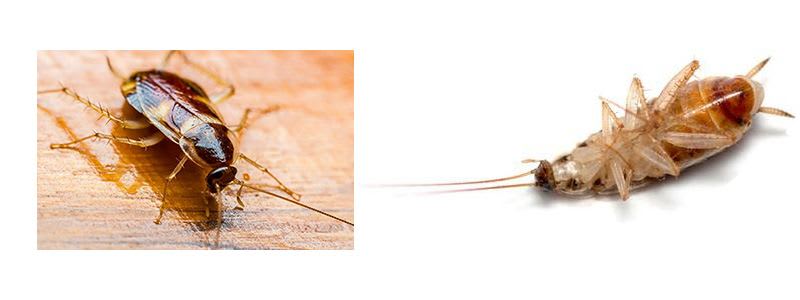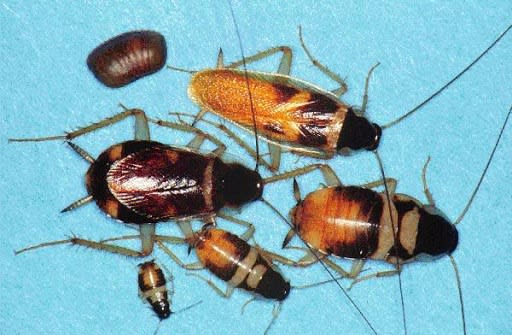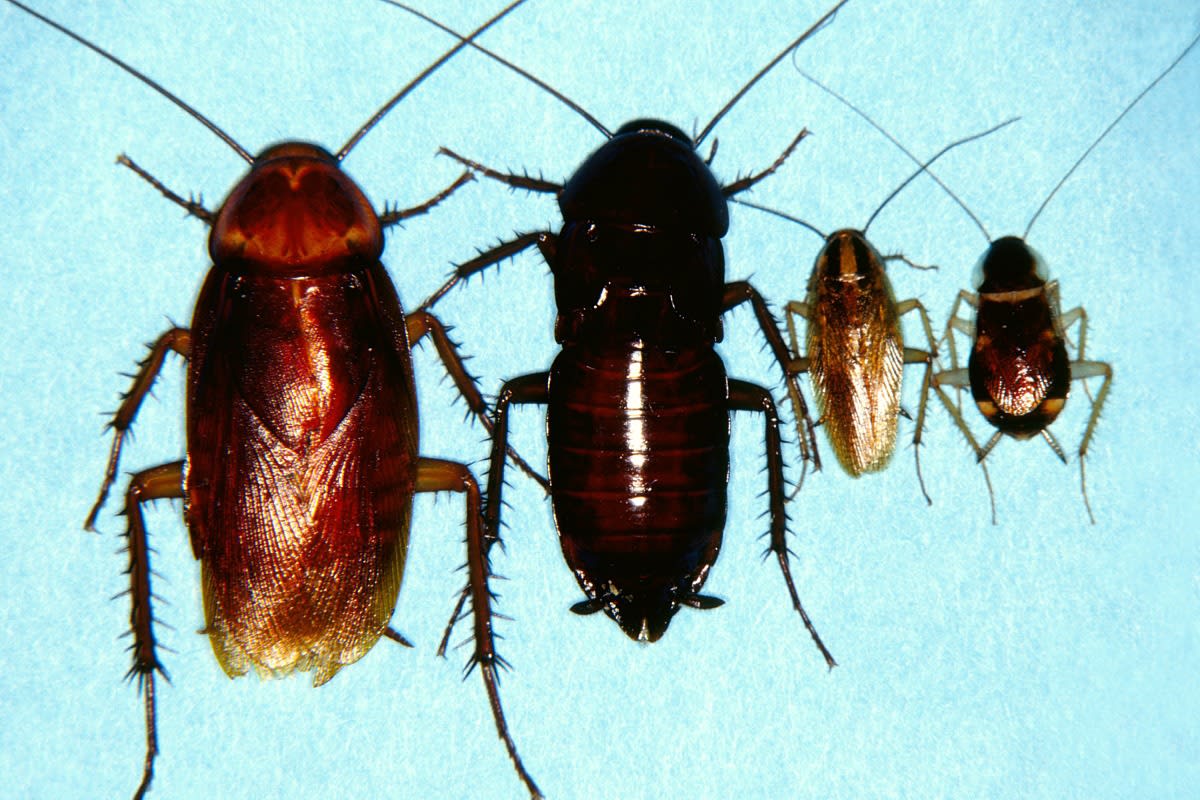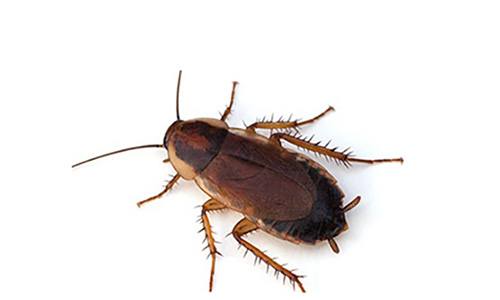
How to Get Rid of Brown Banded Cockroaches
If You Have An Active Brown Banded Infestation, Follow These Guidelines To Exterminate Them

The Brown-Banded Cockroach (Supella longipalpa) is often confused with the German Roach, but its habits are different, but not the treatment methods. Treatment methods are the same for Brown-Banded roaches as the treatments for German roaches.
How Did I Get Brown-Banded Roaches?
- They are often brought in dwellings in furniture. Commonly found in the southern states, but may be found in warmer parts of buildings in the northern states.
- Found only indoors.
- They may be found throughout the building, especially in high areas such as picture frames and ceilings.
Brown-Banded Roach Identification and Inspection

Cockroaches (left–right): American, Oriental, German and Brown-Banded (Photo by Jim Kalisch, UNL Dept. of Entomology)
Brown-Banded Roaches are light brown, about 1/2 inch long. The pronotum is a black bell-shaped pattern with a translucent border. They have two light, irregular bands along with their wings. The wings extend the full length for males and extend 2/3 length for females. Both sexes have wings, but only the male Brown-Banded roach flies.
If you are unsure if you have Brown-Banded roaches, place sticky traps such as Victor Pheromone Traps #327RPT on the kitchen counters at night and take a picture. Send an email with the picture attachment and we will be glad to help you with identification.

Where Brown-Banded Roaches Are Found
- They are often brought in dwellings in furniture. Commonly found in the southern states, but may be found in warmer parts of buildings in the northern states.
- Found only indoors
- May be found behind pictures and inside electrical appliances and electronics
- They may be found throughout the building, especially in high areas such as picture frames and ceilings.
- The brown-banded roach is not as common as the German Roach. Indoor habitats are much less friendly to Brown-Banded roaches since air-conditioning.
- These roaches are brought in from infested furniture, appliances, electronics, and some grocery items. Once inside, they seek shelter in dark recessed areas and spread throughout the building. In the cooler northern states, you may find them in the warmer parts of the building.
Brown-Banded roaches prefer warm, high, and dry places. They can be found throughout the house. They prefer starchy items like glues that bind books, furniture, and wallpaper.
How to Get Rid of Brown-Banded Roaches
First Step: Inspection
Second Step: Sanitation
Third Step: Apply recommended roach control products
Inspection: Look for Evidence
First Step: Inspection
- Look beneath tables and chairs, dressers, and chests.
- Look behind pictures, along with picture moldings.
- Look in closets
- Look at the ceilings and upper walls of cabinets, pantries, and closets.
- Look near motors of refrigerators and other appliances.
- Look in light switches
- Their droppings look like black smears or specks in areas where they run.
- Look in cabinets and ceiling light fixtures, crown moldings, and behind wall hangings, mirrors, and pictures.
Since these roaches are more common during the night, it is easier to inspect during the night-time. They may be seen during the day time, running away when the light is turned on, or a cabinet door is opened.
Droppings
Egg Cases
The Brown-Banded roach egg capsules are less than 0.19 inches and are a yellow-tan color. You may find them in protected cracks and crevices and on the underside of furniture or ceiling lights.

Brown-Banded Roaches and Sanitation Measures
- Kitchen: Wipe up liquid spills in the kitchen and remove oil and crumbs from the countertops and floors.
- Inspect: Inspect furniture before brought into the building.
- Garbage: Keep a tight lid on the garbage cans and or put in a sealed container.
- Seal Up Entry Points: Occasionally, the Brown-Banded roach will enter a structure to inhabit. Seal up any cracks and crevices and around doors and windows, utility lines, and plumbing.
Brown-Banded Roach Control Methods and Products
Brown-Banded Roach Control Measures
Before the application of the recommended insect roach baits and insect growth regulators, it is important to inspect for their activity. A thorough inspection would be required, as they are not restricted to moisture needs in the kitchens and bathrooms. They are more commonly found in other rooms inside the house.
Brown-Banded Roach Insecticides, Baits and IGR's
- As with the German Roach, a good quality roach bait would be recommended for the Brown-Banded Cockroach.
- Follow the same recommended guidelines as the German Roach, but the application would most likely not be restricted to mainly kitchens and bathrooms for German roach control.
- The Brown-Banded and the German Roach are the most challenging of roaches to manage and eliminate. To accurately and completely eliminate these roaches you need to attack them from several tools using baits, dust, growth regulators, and pheromone traps.
- The technology of the pest control market has switched to integrated pest management like baiting, dusting, and the use of insect growth regulators and pheromone traps against the German or Brown-Banded roach, as opposed to just using a residual or contact insecticide either in an aerosol form or liquid form.
- The products we recommend have not had a resistance problem.
- As an addition to bait and IGR placement where you see these roaches inside, you may want to spray a general residual perimeter treatment with a product like Lambdastar UltraCap 9.7. Most of the time, these roaches are brought into your home, but sometimes they can enter seeking shelter from the outside.
Key Takeaway
As with German roaches, a good quality roach bait will work well against brown banded roaches although furniture in dens and bedrooms will often be the center of the infestation rather than the kitchen.
Roach Bait Gel Kits (Combination of Roach Bait Gel and IGR's)
Brown-Banded Cockroach Diet
They eat starchy materials, wallpaper, glue, paste, stamps, and envelopes. As scavengers, they will eat almost anything organic such as decaying matter. They eat non-food items like nylon stockings that have residues from body oils and skin. Both the German roach and Brown-banded roach are dependent on the human habitat for survival.

Habits and Biology of Brown-Banded Cockroaches
Life Stages of Brown-Banded Roaches
Biology
The female will only carry the egg capsule for one or two days, then attach it to a protected surface. Each capsule contains 14-18 eggs, the young reach maturity in about 160 days. You can find these light brown egg capsules usually under or to the sides of a surface, well-protected.
Habits
They don't require the same moisture resources as the German Roach, so they are commonly found in furniture, or on the walls and ceilings. They have the nickname of "furniture roach" because they inhabit furniture. They have a preference for high resting places with many eggs deposited on the upper third of the walls.
They are not as widely found in the kitchen and bathrooms, as the German Roach, but can be located near refrigerator motors and other major appliances.
Adults are very active indoors; adult males fly when they are disturbed. Both the nymph and adult of this roach will jump when disturbed. They prefer dry and warm places and may be scattered throughout the building. These roaches are most active during the night; they avoid light during the daytime. The Brown-Banded roach is common in institutional buildings. They are more common in homes, hotels, apartments, and hospital rooms than in kitchens, restaurants, and stores. They carry disease-causing bacteria.
- Using insect growth regulators break the roach growth cycle.
- Tekko Pro, Tekko Trio, and Tekko Foam stop reproduction and reduces the survival of the Brown-banded roach with two different modes of action. It affects the molting process, making the Brown-Banded roach vulnerable to survival and it stops it at the larvae state.
- The Tekko line of IGRs have changed the industry of Insect Growth Regulators. They have has two or more different active ingredients to provide different modes of action to combat the most severe german roach populations. There have been reports of the complete elimination of the German roach population inside of two weeks when used alone. Combined with the Invict Roach Gel, Vendetta Roach Bait, or Advion WDG non-repellent spray provides the greatest impact.
- Gentrol Point Source is an insect growth regulator in a discreet, non-spray formulation. Gentrol Point Source is a unique device that contains the Gentrol Insect Growth Regulator (IGR) hydroprene for 90-day control of roaches and other stored product pests. Gentrol Point Source covers 75 square feet. All the benefits of an insect growth regulator in a discreet, non-spray formulation.
- Gentrol Complete Aerosol: Gentrol Complete Aerosol is a one-step product, reducing product costs and saving you time. Gentrol Complete Aerosol combines an insect growth regulator to cut the life cycle ( Hydroprene-IGR) and an insecticide (Lambda-Cyhalothrin) to kill the adult stages of many kitchen pests.
How do I use insecticide dusts for German roach control?
The key to insecticide dust application is to use a minimal amount, applying it in a thin layer. It should be hardly visible to the naked eye and never applied to the open area. If you apply dust in heavy applications, the German roaches will walk around the pile or accumulate dust. Use a hand-held duster for accurate dust placement. Only fill the duster half full when dusting. You want airspace on the top of the dust container to shake it and puffed out more quickly. It helps place a couple of pennies inside the dusting container to break up clumps of dust. Applying insecticide dust with a spoon is insufficient.
- Dust should only supplement any insecticide of a bait control program for Brown-banded roach control, not as a stand-alone solution.
- When you apply them to recessed and dry areas, they give you long-lasting results. Typical areas to dust would be electrical outlets, so a hand duster with a plastic tip would be needed.
- Dust cracks and crevices near baseboards and entry points like doors and windows.
- Do not place this dust in the same location as any roach baits, as it would contaminate the baits.
Written by our resident pest control expert Ken Martin.










